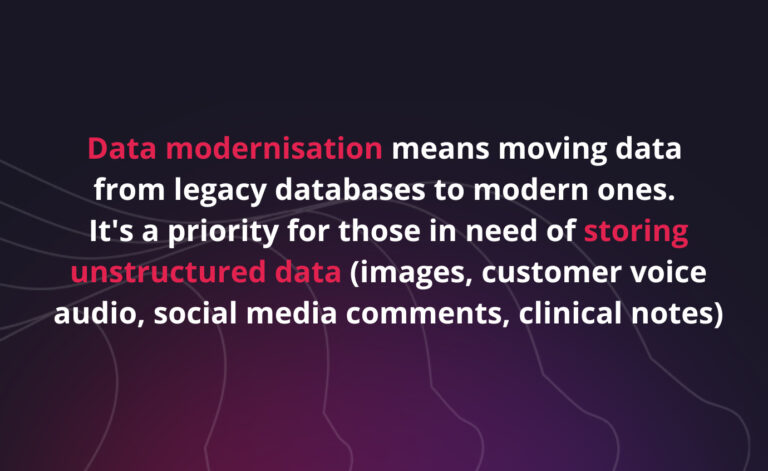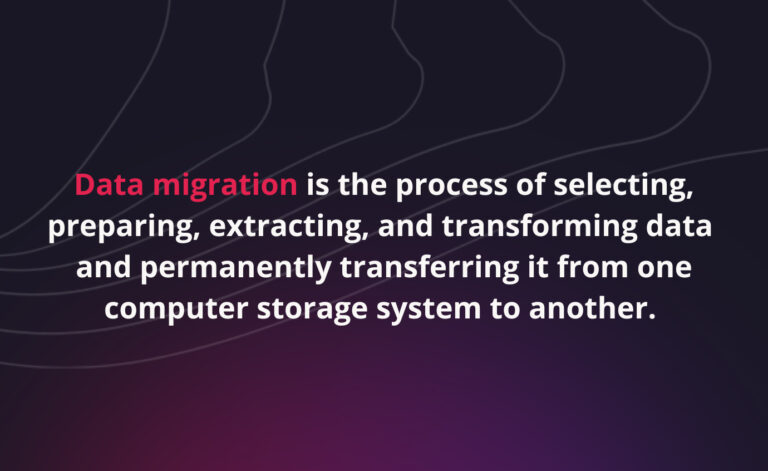Table of Contents
Even the world’s largest companies struggle to manage the huge volume of data they generate and collect. That’s why data migrations, particularly cloud migrations, are becoming extremely important.
According to McKinsey, companies that adhere to successful cloud migration best practices can potentially unlock nearly $1 trillion in value. So, while the benefits of cloud computing are well known, many companies see even greater potential in hybrid and multi-cloud setups. This trend is part of a broader, ongoing effort by organizations to modernize their IT infrastructure.

However, 83% of data migrations fail to meet expectations, often running behind schedule and over budget. What slows the progress?
- Data silos across the organization
- Expanding data volumes
- Manual dashboards with delayed indicators
- Increasing costs of data storage and processing
Data modernization process: top trends for 2024
Data modernization is a missing puzzle of a successful cloud migration process, involving system optimization to ensure a smooth transition and integration with cloud platforms. Today, several tech trends are set to redefine the way we treat data.

Cloud migration
Most industries are transferring data and applications to cloud platforms to achieve enhanced scalability, flexibility, and cost-efficiency. This approach enables organizations to use full suite of cloud infrastructure solutions available, ensuring seamless data access from any location and reducing dependence on on-premises hardware.
Data governance
As data volume continues to grow, ensuring its quality, integrity, and compliance has become a top priority. Data governance helps establish frameworks that define policies, processes, and controls for efficient data management. This ensures transparency and trust across the organization.
Blogpost spotlight: Common data quality problems that hold your organisation back

AI-powered data analytics
Artificial intelligence and machine learning represent the future of data analysis. These technologies empower organizations to extract valuable insights and patterns from vast datasets. Predictive modeling and natural language processing enable businesses to make more informed decisions with precise and efficient results.
Real-time data integration
The ability to access and analyze data is a must for your sustainability and competitiveness. Real-time integration solutions enable organizations to accurately capture, process, and deliver data.
Data democratization
Empowering employees across all levels to access and analyze data fosters a culture where decisions are based on internal facts. Democratizing data involves equipping employees with the necessary tools, training, and support to work effectively with data, streamlining decision-making by reducing reliance on intermediaries.
Adoption of data mesh architecture
Moving away from traditional centralized data architecture, adopting decentralized and scalable approaches like data mesh architecture effectively distributes data ownership and management responsibilities.
Embracing data modernization: benefits
Data modernization initiative offers many benefits, from improved decision-making to streamlined processes. Let’s explore some key advantages driving the success of data modernization trends.
Improved decision-making
Accessing the right data at the right time, along with advanced tools, empowers companies to make data-driven decisions. In this case, organizations can strategically lead the digital transformation.
Increased operational efficiency
Implementing streamlined data processes and adopting effective data management practices improves operational efficiency and overall productivity. As a result, businesses accomplish more tasks with fewer resources, optimizing resource allocation.
Enhanced business agility
Modernizing data infrastructure and embracing agile practices empower businesses to swiftly adapt to changes in market dynamics and customer needs.
Better customer experience
Delivering a satisfactory customer experience is paramount for any business. Using data to create personalized experiences enables businesses to connect with customers on a personal level, making them feel valued and satisfied. This approach not only enhances customer retention but also contributes to increased sales.
Why migrate your data warehouse to the cloud: top factors

Scaling with flexibility and adaptability
One of the main benefits of migrating your data warehouse to the cloud is scalability, which allows your company to easily adjust its IT resources based on changing needs. Cloud computing demonstrates its strength by offering on-demand growth and adaptability, as there is no one-size-fits-all solution for data management.
Learn how to monetise data and improve your revenue model
Data warehouse modernization provides businesses with an infrastructure that can easily scale when necessary. This is achieved through the autonomous scaling or de-scaling of servers, storage, and network bandwidth, enabling the management of massive data volumes with exceptional efficiency. The cloud eliminates integration and optimization issues typically associated with traditional on-premises systems.
For long-term success, businesses are experimenting with various data modeling techniques to maximize the benefits of cloud-based data warehouses. This flexibility allows companies to adapt their data strategies as their needs evolve.
Cost-efficiency
Migrating your data warehouse to the cloud offers several commercial advantages, primarily cost-effectiveness.

Reduced upfront costs
- On-premises: Significant initial investments in technology and software licenses.
- Cloud: The pay-as-you-go model aligns expenditures with actual usage.
Lower operational expenses
- On-premises: Ongoing maintenance costs for hardware and software.
- Cloud: Reduced maintenance costs and no need for hardware purchases.
Improved resource allocation
- On-premises: Risk of underutilized resources.
- Cloud: Scale resources as needed, minimizing waste.
Cost optimization options
- For further savings, cloud providers offer various pricing models (e.g., reserved instances, spot instances).
Advanced capabilities
- Cloud platforms provide access to cutting-edge analytics tools without additional infrastructure costs.
To sum up, migrating to a cloud-based data warehouse can significantly reduce the total cost of ownership while enhancing analytical capabilities.
Design for the present and the future needs
Taking advantage of any technology to drive growth and innovation serves as a powerful enabler and driver. This involves staying abreast of advancements and optimizing all processes for reliability.
Consider the advantages of zero-code ETL tools, self-service BI, and data warehouse automation platforms alongside the rapid developments in each domain. With these state-of-the-art platforms and solutions, you can confidently meet new business demands swiftly and at scale.
AI and advanced analytics
As you know, organizations are ongoingly relying on AI and advanced analytics to gather valuable insights. Cloud-based data warehousing platforms provide a reliable foundation for implementing complex analytics solutions. Through integration with other cloud services like machine learning and AI platforms, businesses use predictive and prescriptive analytics to uncover hidden trends, detect anomalies, and make data-driven forecasts. The cloud’s flexibility and scalability enable companies to experiment with various analytics methods and effortlessly expand their infrastructure to accommodate growing AI workloads.
Data security and compliance
Cloud providers offer superior security compared to traditional on-premises solutions due to their substantial investment in security measures and commitment to industry best practices. By migrating your data warehouse to the cloud, you can use advanced security features such as encryption, data masking, identity and access control, and continuous monitoring.
Cloud providers also undergo frequent audits and maintain industry-specific certifications to ensure compliance with local and industry regulations. Entrusting your data to a reputable cloud provider enhances overall data security and facilitates better compliance adherence.
Examples of successful cloud migrations
Recent industry research shows that approximately 91% of businesses have adopted cloud-based technologies to some degree. Such a common trend has prompted many businesses to consider migrating their operations to the cloud.
Netflix
Netflix stands out as an excellent example of successful cloud migration. Over a span of seven years, the company transitioned its entire operation to the AWS cloud. This strategic data migration project facilitated Netflix’s rapid scalability, empowering the addition of millions of new users and its expansion into more than 190 countries.

GE Oil & Gas
In a swift transition, GE Oil & Gas transferred over 500 applications to AWS within a year. This migration slashed their total cost of ownership by 52%, significantly boosting their agility and operational efficiency.

Unilever
Over a span of 18 months, Unilever successfully migrated more than 500 web properties to AWS. This initiative resulted in a 5x increase in digital marketing speed and a 40% reduction in hosting costs.

How much does it cost to migrate legacy systems to modern platforms
Determining the cost of software migration is often the major concern for business owners contemplating the shift. For example, according to Clutch, the average costs for application development typically range from $10,000 to $49,000, with variations depending on several factors.
At the same time, the cost of software migration is influenced by several factors, such as size, complexity, integration requirements, and the service provider chosen. Generally, depending on these factors, software migration costs can range from $40,000 to $150,000 or more.
For smaller applications, the cost of migrating legacy software typically falls between $30,000 to $70,000, taking into account additional considerations. Medium to large-scale software migrations, however, can exceed $150,000.
The final words
Different cloud adoption scenarios require distinct approaches. The modernization strategy is particularly compelling, offering both business transformation and long-term cost benefits.
An alternative approach is the ‘migrate then modernize’ model. This strategy allows organizations to quickly move from on-premises infrastructure to the cloud, followed by gradual modernization of workloads within the cloud environment. This approach combines the advantages of rapid migration with the benefits of ongoing modernization.
At Altamira, we optimize operations performance and unleash the full potential of your data assets, helping you with:
- Discovery and assessment
- Migration and modernization
- Analytics modernization
- Data governance
What problems do we usually resolve?
- Data quality, accessibility, and fragmentation-related issues
- Underused data, not leveraged for internal insights or monetization purposes
- Datasets validation, cleansing, and augmentation before using advanced AI/ML solutions
- Data management processes integration to ensure proper data quality for future usage
Adopting DataOps principles in daily operations helps establish solid foundations for using artificial intelligence and machine learning. Contact us to get a free expert consultation and get answers for each and every concern that holds you back.




